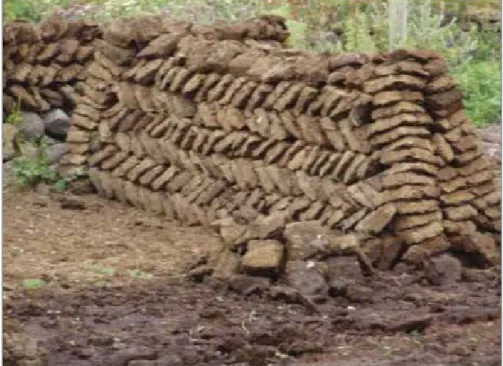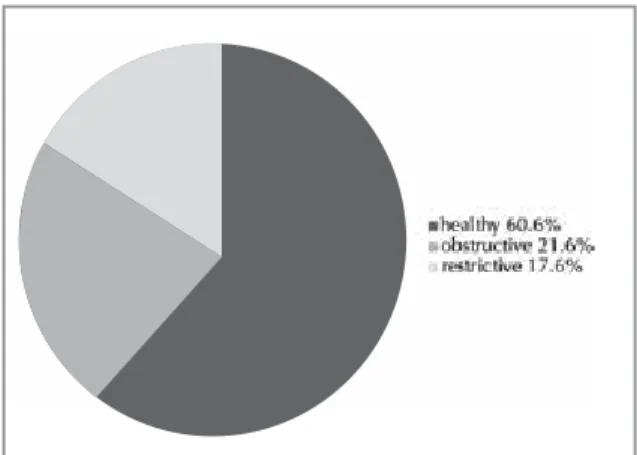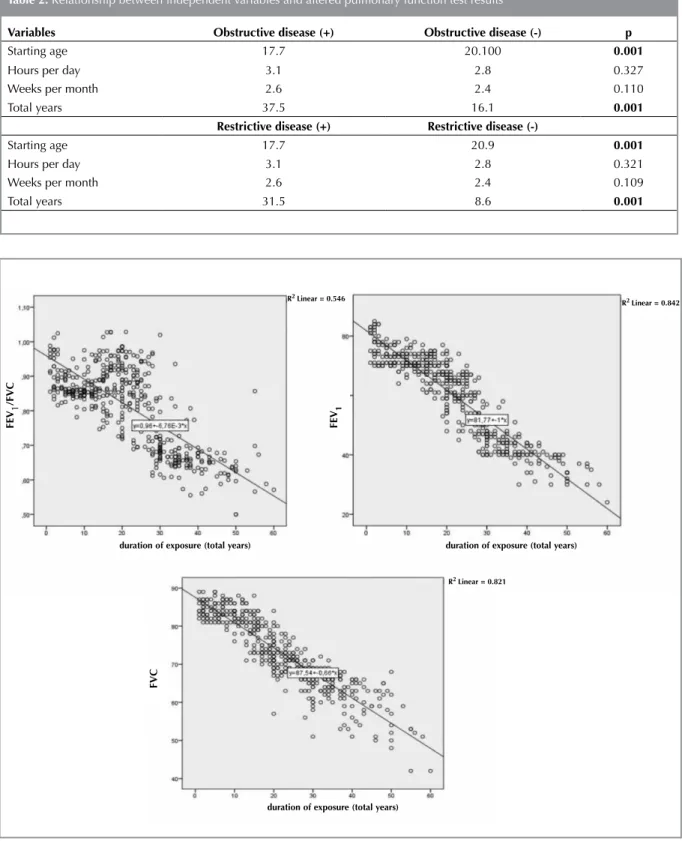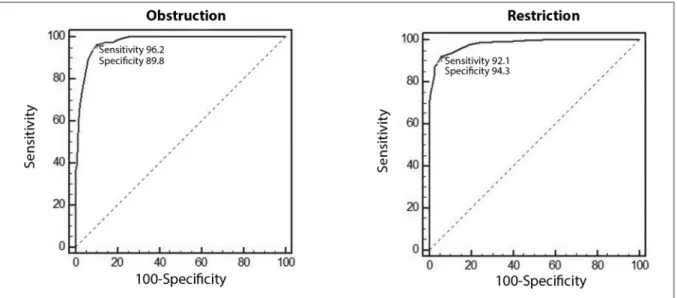122
Altered pulmonary functions due to
biomass smoke in a rural population of
Turkish women: a descriptive study
doi • 10.5578/tt.54027
Tuberk Toraks 2018;66(2):122-129
Geliş Tarihi/Received: 06.04.2017 • Kabul Ediliş Tarihi/Accepted: 06.11.2017
KLİNİK Ç
ALIŞMA
RESEARCH
AR
TICLE
Baran BALCAN1 Selçuk AKAN2 Aylin ÖZSANCAK UĞURLU3 Berrin CEYHAN11 Clinic of Chest Diseases, Marmara University Training and Research
Hospital, Istanbul, Turkey
1 Marmara Üniversitesi Eğitim ve Araştırma Hastanesi, Göğüs Hastalıkları Kliniği, İstanbul, Türkiye
2 Clinic of Internal Medicine, Ankara Atatürk Training and Research Hospital,
Ankara, Turkey
2 Ankara Atatürk Eğitim ve Araştırma Hastanesi, İç Hastalıkları Kliniği, Ankara, Türkiye
3Department of Chest Diseases, Baskent University Istanbul Health Practice
and Research Center, Istanbul, Turkey
3 Başkent Üniversitesi İstanbul Uygulama ve Araştırma Merkezi, Göğüs Hastalıkları Anabilim Dalı, İstanbul, Türkiye
SUMMARY
Altered pulmonary functions due to biomass smoke in a rural population of Turkish women: a descriptive study
Introduction: Wood or other organic sources of fuel are used as source of energy for heating or cooking particularly in developing
countries. The aim of the current study was to evaluate the association between biomass exposure time and parameters of pulmonary function tests.
Materials and Methods: Four hundred twenty-four consecutive women who lived and exposed to biomass smoke in a small province
in Eastern Turkey were involved. This study was performed with women who had come to pulmonology out-patient clinic with symptom of dyspnea.
Results: The independent variables assessed in the study patients were age, BMI, starting age of cooking, hours per day and weeks
per month spent cooking, and cooking years; the dependent variables were PFT parameters. Ninety-two (21.6%) patients had an obstructive PFT pattern. Sixty-seven (73%) of these patients were classified as GOLD 2 and 25 (27%) patients were classified as GOLD 3. Seventy-five (17.6 %) of the patients had restrictive lung disease; 54 (72%) of these patients were found to have a mild and 21 (27%) had a moderate restrictive pattern. Increased number of years in cooking and to start cooking at younger ages were a risk factors for the development of obstructive and restrictive
disease. There was a statistically significant and negative correlation between increased number of years and the value of FEV1 (r= -0.917; p=< 0.001), FEV1/FVC (r= -0.739; p< 0.001), and FVC (r= -0.906; p< 0.001). The median time of cooking required was 23 years for the development of obstruction, and 25 years for restriction, respectively.
Conclusion: Cumulative biomass exposure time is associated with
impairment in PFT parameters; results in both obstructive and
Dr. Baran BALCAn
Marmara Üniversitesi Pendik Eğitim ve Araştırma Hastanesi, Göğüs Hastalıkları Anabilim Dalı,
İSTAnBUL - TÜRKİYE
e-mail: drbaranbalcan@yahoo.com
Yazışma Adresi (Address for Correspondence)
INTRODUCTION
Wood and other sources of fuel such as animal dung and organic food products are used as a source of energy for heating and cooking, particularly in developing countries (1,2). Approximately 3 billion people worldwide are exposed to biomass fuel smoke (3). Chronic obstructive pulmonary disease (COPD) is increasingly becoming a serious public health problem (4). Smoking is a leading risk factor for the development of COPD in developed countries and in the male population; however, biomass exposure is another important risk factor in the development of COPD in places where indoor ventilation is insufficient (2,5). Biomass exposure is associated with changes in pulmonary tissue. It causes fibrosis in lung architecture, particularly in individuals who use non-wood organic materials as a fuel source, and this exposure can cause restrictive pulmonary disease (6-9). Many studies have shown a relationship between COPD and biomass exposure by analyzing subgroups according to sex, smoking status, and source of energy used as fuel (10-14). However, very few of these studies have clearly identified a critical period of time for the development of pulmonary disease. The aim of the present study was to evaluate the relationship between the parameters of the pulmonary function test and the duration.
MATERIALS and METHODS Study Design
Many women who live in the villages in the Eastern Anatolia Region of Turkey are involved in cooking bread in floor furnaces (tandoor). These individuals are exposed to heavy smoke due to the cooking principles (lack of chimney and poor smoke ventilation) (Figure 1). Dry animal dung (manure), rather than wood and charcoal, is used as the fuel source (Figure 2). This study was performed between January 2013 and December 2013 among women who had come to pulmonology out-patient clinic of Kagizman state hospital with symptom of dyspnea. In one year period 945 women were evaluated; current and former smokers; patients with known heart failure, chronic renal failure, history of bronchiectasis, asthma and allergy; those who had received therapy due to upper or lower respiratory infections in the past month were excluded from the study, and the patients who did not want to participate the study were excluded, and finally with 424 women the study was performed. Pulmonary function tests (PFT) were performed after obtaining the patient’s consent for the study. A PFT device (MIR; Spirolab III; USA) was used on each patient after being calibrated by a PFT technician, and best of three acceptable with good graphs of spirometry restrictive lung disease. Biomass exposure is a public health problem and pre-cautions should be taken in order to prevent impaired pulmonary functions.
Key words: Biomass; pulmonary function testing; exposure ÖZET
Kırsal alanda yaşayan kadınlarda biyomas dumanına bağlı solunum fonksiyon kapasitesinde bozulma
giriş: Odun ve organik maddeler, özellikle gelişmekte olan ülkelerde ısınma ve yemek pişirme amaçlı enerji kaynağı olarak
kullanıl-maktadır. Bu çalışmada biyomas dumanına maruz kalınan süre ile bozulan solunum fonksiyon testi parametreleri arasındaki ilişki değerlendirilmiştir.
Materyal ve Metod: Bu çalışma doğuanadolu bölgesinde bir kasabada yaşayan biyomas dumanına maruz kalmış kadınlarla yapılmıştır.
Hastalar göğüs hastalıkları polikliniğine nefes darlığı ile başvuran kişiler arasında seçilmiştir.
Bulgular: Bağımlı değişken, solunum fonksiyon testi sonuçları ve bağımsız değişkenler, yaş, vücut kitle indeksi, tandır yapmaya başlama
yaşı, ayın kaç haftası tandır yaptığı, tandır başında geçen süre (saat), toplam tandır süresi (yıl). Hastaların 92 (%21.6)'sinde obstrüktif patern gözlenmiş, ve bu hastaların 67 (%73)'si GOLD 2.25 (%27)'i GOLD 3 olarak sınıflandırılmıştır. Hastaların 75'inde restriktif paterne rastlan-mış ve bu hastaların 54 (%72)'ü hafif, 21 (%28)'i orta restritif tiptedir. Erken yaşta tandır yapmaya başlamak ve tandır başında geçen süre (yıl) restriktif ve obstrüktif akciğer hastalığı gelişmesinde risk faktörüdür. Tandır yılı ile FEV1 (r= -0.917; p= < 0.001), FEV1/FVC (r= -0.739; p< 0.001) ve FVC (r= -0906; p< 0.001) arasında negatif korelasyon vardır. Hastalarda obstrüksiyon gelişmesi için toplam 23 yıl ve restrik-siyon gelişmesi için de 25 yıl tandır yapılması gerekmektedir.
Sonuç: Tandır yapımında geçen süre arttıkça hastalarda hem restriktif hem de obstrüktif tipte solunum yetmezliği gözlenmektedir.
Biyomasa maruz kalmaya bağlı ortaya çıkan bu halk sağlığı problemine karşı gerekli önlemler alınmalıdır.
Tuberk Toraks 2018;66(2):122-129 124
was accepted. Post-bronchodilator forced expiratory volume (FEV1), forced vital capacity (FVC), and forced expiratory flow (FEF) 25-75% parameters were recorded. FEV1/FVC < 70% as obstruction, and FVC < 80% plus FEV1/FVC > 70 as restriction, based on the standardized parameters determined by the American Thoracic Society (ATS)/European Respiratory Society (ERS) (15). Patients who were diagnosed as having COPD were classified according to the Global Initiative for Chronic Obstructive Lung Disease (GOLD) as mild, moderate, severe, and very severe (16). In terms of restriction, FVC > 80 mL were classified as normal, 65-80 mL as mild, 51-65 mL as moderate, and < 50 mL as severe restriction (17). Beside PFT results of the patients, the association between the duration of biomass smoke with obstructive and restrictive lung disease were evaluated.
The study was conducted in accordance with the guidelines of the “Declaration of Helsinki” and approved by the local ethical committee of Kars provenience.
Figure 1. Lack of chimney and poor smoke ventilation.
Statistics
SPSS (Statistical Packages for the Social Sciences) version 21.0 (IBM Corporation, Armonk, nY, USA) and Med Calc statistical software were used in the statistical analyses. Descriptive statistics [frequency, percentage, mean (min-max)] were used to evaluate the study data. The independent sample t-test was used to compare parameters between the groups. A one-way AnOVA test was used to compare the parameters between more than one group, and the Bonferroni test was used to determine the group that showed a significant difference. Pearson’s correlation analysis was used to evaluate the relationship between duration as years, and PFT. A ROC curve analysis was performed to determine the cut-off levels of the parameters, and sensitivity and specificity were calculated based on the cut-off value.
RESULTS
A total of 424 eligible patients were included in the study. The independent variables assessed in the study patients were age, BMI, starting age of cooking, hours per day and weeks per month spent cooking, and cooking years; the dependent variables were PFT parameters (Table 1). The distribution of the patients based on PFT results was as given in figure 3. Of the patients evaluated in the study, 92 (21.6%) had an obstructive PFT pattern. Sixty-seven (73%) of these patients were classified as GOLD 2 (moderate obstruc-tion) and 25 (27%) patients were classified as GOLD 3 (severe obstruction). Seventy-five (17.6 %) of the patients had restrictive lung disease; 54 (72%) of these
patients were found to have a mild restriction and 21 (27%) had a moderate restrictive pattern.
In table 2 associations between PFTs and independent variables (age, hours per day, weeks per month, and total years) were evaluated. There was a negative and statistically significant relationship between starting to cook in smaller ages and existence of both obstructive and restrictive pulmonary functions. Moreover, there was a positive and statistically significant relationship between total years spent in cooking and altered pul-monary functions. However there was no statistically significant between hours per day, and weeks per month and altered pulmonary functions.
Figure 4 summarizes the correlation analysis between duration of exposure in years and PFT parameters. There was a statistically significant and negative correlation between increased number of years and the value of FEV1(r= -0.917; p= < 0.001), FEV1/FVC (r= -0.739; p< 0.001), and FVC (r= -0.906; p< 0.001). We also did ROC curve analysis in order to determine the required number of years for existence of pathologic PFT patterns. The median time of cooking required was 23 years for the development of obstruction, and 25 years for restriction, respectively (Figure 5).
Figure 3. Distribution of pulmonary function test results among the evaluated patients.
Variables n (min-max)
Age 41.5 (18-86)
BMI 26.2 (20.1-42.9)
Starting age 18.1 (11-49)
Daily hours spent in cooking 3.2 (1-5) Weeks/month spent in cooking 3.2 (1-4) Total years spent in cooking 20.6 (1-65)
FEV1 (Lt) 1.92 (0.58-3.46) FEV1 (%) 69 (39-97) FVC (Lt) 2.54 (0.95-3.96) FVC (%) 81 (51-99) FEV1/FVC (%) 74 (52-96) FEF 25-75 (%) 59 (32-115)
FEV1 (forced expiratory volume), FVC (forced vital capa-city), FEF 25-75 (forced expiratory flow), BMI (body mass index).
Table 1. Median values of evaluated dependent and inde-pendent parameters
Tuberk Toraks 2018;66(2):122-129 126
Table 2. Relationship between independent variables and altered pulmonary function test results
Variables Obstructive disease (+) Obstructive disease (-) p
Starting age 17.7 20.100 0.001
Hours per day 3.1 2.8 0.327
Weeks per month 2.6 2.4 0.110
Total years 37.5 16.1 0.001
Restrictive disease (+) Restrictive disease (-)
Starting age 17.7 20.9 0.001
Hours per day 3.1 2.8 0.321
Weeks per month 2.6 2.4 0.109
Total years 31.5 8.6 0.001
Figure 4. Graphics of correlation analysis between duration (total exposure year) with FEV1, FEV1/FVC, FVC.
FEV
1
/FVC
R2 Linear = 0.546
duration of exposure (total years) duration of exposure (total years)
FVC
FEV
1
R2 Linear = 0.821
duration of exposure (total years)
Figure 5. ROC curves of duration (total exposure year) obstruction, and restriction.
DISCUSSION
In this cross-sectional study, we found that increased number of cooking year is related to altered PFT results. As the duration of biomass exposure increased, the possibility of severity of obstruction and restriction was higher. There was a negative correlation between num-ber of years spent cooking and PFT parameters. There were also cut-off values for the duration for the exis-tence of altered PFT results.
Chronic biomass exposure causes infiltration of macrophages in the alveolar space, thickening in the bronchial wall, and a continuous inflammatory process in the airways, which results in an impairment in pulmonary function (18). In the present study, FEV1, and FVC values decreased with increased duration of exposure to biomass smoke, 92 patients were found to have COPD according to the GOLD classification, and the probability, and the severity of COPD increased with increasing years of exposure. Similar results were reported in the studies by Ramirez Venegas et al. and Regalado et al. (19,20). These authors found that COPD developed in subjects exposed to biomass and reported advanced stages of COPD with increased duration and intensity of exposure. In another study, PFT parameters were evaluated in subjects with biomass exposure; although no statistically significant difference was observed, possibly due to the low number of subjects, the likelihood of developing COPD was higher in patients who were exposed to biomass smoke (21). Studies by Sezer et al. Ekici et al. and Gunen et al.
conducted in Turkey showed a relationship between biomass exposure and the development of COPD (11,13,22). Biomass exposure is the second most important risk factor for the development of COPD; however, the question is how soon individuals develop COPD after initiation of biomass exposure. Although recent studies about biomass exposure did not mention a specific time period as in our study (23 years), Caballero et al. estimated 10 years and above, and Dossing et al. estimated 20 years and above, as the time period for the development of COPD (10,14). In a similar study by Orozco-Levi et al., the mean duration of biomass exposure was 18 years in patients with COPD, and they suggested that the risk of developing COPD was higher as the duration of exposure increased (12).
In the present study, spirometric analysis revealed FVC < 80% in 75 patients. According to the information in the literature, obstructive pattern respiratory disease is anticipated in subjects with biomass exposure. Animal dung (manure) was the source of energy of biomass fuel in our study. Burning dry dung results in various reac-tions that cause fibrosis in lung tissue, and this is asso-ciated with the development of restrictive lung disease. In the studies by Arslan et al. and Kara et al. , comput-erized tomography (CT) of the lungs of patients with biomass exposure revealed fibrotic bands, nodular opacities, and perivascular thickening, which are the radiologic signs of restrictive lung disease; therefore, the authors suggested restrictive pulmonary disease could
Tuberk Toraks 2018;66(2):122-129 128
et al. observed restrictive lung disease in children with biomass exposure; however, in contrast to the literature, obstruction (FEV1/FVC < 0.7) was not observed in these children despite decreased FEV1 values (8). In the study by Kargin et al., the authors evaluated 46 patients who had biomass exposure, and similar to our results, they suggested biomass exposure may be the reason for combined restrictive and obstructive pulmonary disease (9).
There is a positive correlation between number of years and value of CEI with altered pulmonary functions. When the duration of biomass smoke exposure is high, the probability of pulmonary dysfunction is also elevated, as would be expected. This finding is consistent with findings of prior studies (9,13,14).
STUDY LIMITATIONS
If it were possible to perform pulmonary imaging studies, particularly computerized tomography of the lungs, it would be possible to differentiate chronic bronchitis from emphysema and show reticulonodular appearance and fibrosis that could cause restrictive patterns. However, the main focus of the present study was to determine the relationship between biomass exposure and changes in pulmonary function tests, and not to reach conclusions based on imaging studies. In conclusion, biomass exposure is associated with impairments in the parameters of RFT. A respiratory disease characterized by an obstructive pattern is inev-itable, as would be expected for patients who were exposed to smoke. The use of organic materials (dry animal dung) as a fuel source, as in the present study, may cause pulmonary fibrosis and, as a result, lead to restrictive pulmonary disease.
There is no financial support for the study, and conflict of interest for any authors.
RE FE REN CES
1. Bruce N, Perez-Padilla R, Albalak R. Indoor air pollution in developing countries: A major environmental and public health challenge. Bull World Health Organ 2000;78:1078-92.
2. de Koning HW, Smith KR, Last JM. Biomass fuel combustion and health. Bulletin of the World Health Organization 1985;63:11-26.
3. Rehfuess E, Mehta S, Pruss-Ustun A. Assessing household solid fuel use: Multiple implications for the millennium development goals. Environmental health perspectives 2006;114:373-8.
4. Murray CJ, Lopez AD. Alternative projections of mortality and disability by cause 1990-2020: Global burden of disease study. Lancet 1997;349:1498-504.
5. Chen BH, Hong CJ, Pandey MR, Smith KR. Indoor air pollution in developing countries. World health statistics quarterly. Rapport Trimestriel de Statistiques Sanitaires mondiales 1990;43:127-38.
6. Kara M, Bulut S, Tas F, Akkurt I, Seyfikli Z. Evaluation of pulmonary changes due to biomass fuels using high-resolution computed tomography. European Radiology 2003;13:2372-7.
7. Arslan M, Akkurt I, Egilmez H, Atalar M, Salk I. Biomass exposure and the high-resolution computed tomographic and spirometric findings. European journal of Radiology 2004;52:192-9.
8. Rinne ST, Rodas EJ, Bender BS, Rinne ML, Simpson JM, Galer-Unti R, et al. Relationship of pulmonary function among women and children to indoor air pollution from biomass use in rural ecuador. Respiratory Medicine 2006;100:1208-15.
9. Kargin R, Kargin F, Mutlu H, Emiroglu Y, Pala S, Akcakoyun M, et al. Long-term exposure to biomass fuel and its relation to systolic and diastolic biventricular performance in addition to obstructive and restrictive lung diseases. Echocardiography (Mount Kisco, N.Y.) 2011;28:52-61. 10. Dossing M, Khan J, al-Rabiah F. Risk factors for chronic
obstructive lung disease in saudi arabia. Respiratory Medicine 1994;88:519-22.
11. Ekici A, Ekici M, Kurtipek E, Akin A, Arslan M, Kara T, et al. Obstructive airway diseases in women exposed to biomass smoke. Environmental Research 2005;99:93-8.
12. Orozco-Levi M, Garcia-Aymerich J, Villar J, Ramirez-Sarmiento A, Anto JM, Gea J. Wood smoke exposure and risk of chronic obstructive pulmonary disease. The European Respiratory Journal 2006;27:542-6.
13. Sezer H, Akkurt I, Guler N, Marakoglu K, Berk S. A case-control study on the effect of exposure to different substances on the development of copd. Annals of Epidemiology 2006;16:59-62.
14. Caballero A, Torres-Duque CA, Jaramillo C, Bolivar F, Sanabria F, Osorio P, et al. Prevalence of copd in five colombian cities situated at low, medium, and high altitude (prepocol study). Chest 2008;133:343-349.
15. Celli BR, MacNee W. Standards for the diagnosis and treatment of patients with copd: A summary of the ats/ers position paper. The European Respiratory Journal 2004;23:932-46.
16. Han MK, Muellerova H, Curran-Everett D, Dransfield MT, Washko GR, Regan EA, et al. Gold 2011 disease severity classification in copdgene: A prospective cohort study. The Lancet. Respiratory Medicine 2013;1:43-50.
17. Celli BR, Halbert RJ, Nordyke RJ, Schau B. Airway obstruction in never smokers: Results from the third national health and nutrition examination survey. The American Journal of Medicine 2005;118:1364-72. 18. Mena MA, Woll F, Cok J, Ferrufino JC, Accinelli RA.
Histopathological lung changes in children due to biomass fuel. American Journal of Respiratory and Critical Care Medicine 2012;185:687-8.
19. Ramirez-Venegas A, Sansores RH, Quintana-Carrillo RH, Velazquez-Uncal M, Hernandez-Zenteno RJ, Sanchez-Romero C, et al. Fev1 decline in patients with chronic obstructive pulmonary disease associated with biomass exposure. American journal of Respiratory and Critical Care Medicine 2014;190:996-1002.
20. Regalado J, Perez-Padilla R, Sansores R, Paramo Ramirez JI, Brauer M, Pare P, et al. The effect of biomass burning on respiratory symptoms and lung function in rural mexican women. American Journal of Respiratory and Critical Care Medicine 2006;174:901-5.
21. Raj TJ. Altered lung function test in asymptomatic women using biomass fuel for cooking. Journal of clinical and diagnostic research: JCDR 2014;8:Bc01-03.
22. Gunen H, Hacievliyagil SS, Yetkin O, Gulbas G, Mutlu LC, Pehlivan E. Prevalence of copd: First epidemiological study of a large region in turkey. European Journal of Internal Medicine 2008;19:499-504.



